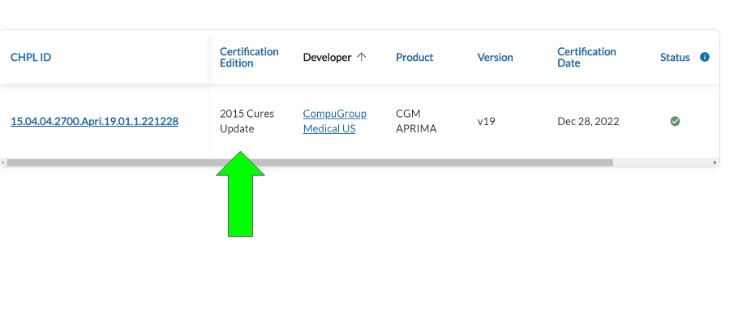
The final blog in our five-part series, Mastering MIPS, reviews the Promoting Interoperability (PI) category. This category promotes patient engagement and the electronic exchange of information using certified electronic health record technology (CEHRT). In this blog, we provide an overview of the PI reporting requirements and share valuable tips to ensure successful reporting.
What are the Requirements?
In 2023 the PI category has a minimum performance period of 90 continuous days between January 1, 2023, and December 31, 2023. Reporting this category requires that you use an Electronic Health Record (EHR) that meets the 2015 Edition Cures Update certification criteria. When checking your EHR’s certification edition on the Certified Health IT Product List (CHPL) you will want to look for “2015 Cures Update” as shown in the illustration below.

What’s New in 2023?
This year the Centers for Medicare and Medicaid Services (CMS) made several changes to the PI category:
- EHR technology must be certified to the 2015 Edition Cures Update certification criteria.
- The Electronic Prescribing Objective’s Query of Prescription Drug Monitoring Program (PDMP) is now a required measure (exclusions were added).
- The Query of PDMP measure was expanded to include not only Schedule II opioids, but also Schedule III, and IV drugs.
- A new third option was added to the Health Information Exchange (HIE) Objective called the Enabling Exchange under the Trusted Exchange Framework and Common Agreement (TEFCA) measure (requiring a yes/no response). This is an optional alternative to fulfill the objective.
- The active engagement options in the Public Health and Clinical Data Exchange Objective were consolidated from three to two levels and your level of active engagement must now be reported for the required measures.
- Automatic reweighting of the PI category was discontinued for nurse practitioners, physician assistants, certified registered nurse anesthetists, and clinical nurse specialists.
- The maximum points for some PI measures were updated.
Do I Have to Report the PI Category?
The PI category is worth 25% of your final MIPS score if you are reporting in the traditional MIPS program. However, this percentage can change due to special statuses, hardship exception applications, or Alternative Payment Model (APM) Entity participation.
Automatic Reweighting
The following clinician types are exempt from reporting the PI category and do not need to submit a PI hardship exception application. If these clinicians do not report any PI data, the category will be automatically reweighted to 0% and the 25% will be added to other MIPS categories.
- Clinical social workers
- Physical therapists
- Occupational therapists
- Qualified speech-language pathologists
- Qualified audiologists
- Clinical psychologists, and
- Registered dieticians or nutrition professionals
Clinicians and groups with the following “special status” designations also qualify for automatic reweighting and will not have to submit a PI hardship exception application:
- Small practices (15 or fewer clinicians)
- Ambulatory Surgical Center (ASC)-based
- Hospital-based
- Non-patient facing
A group qualifies for automatic reweighting when 100% of the MIPS eligible clinicians in the group qualify for reweighting as individuals for any combination of reasons.
Hardship Exceptions
If you or your group does not qualify for PI to be automatically reweighted, you can apply to CMS to obtain an exemption from the PI category due to a “significant hardship”. The deadline to submit applications to CMS is January 2, 2024.
Exception applications must be based on one of the following reasons:
- Using decertified EHR technology
- Insufficient Internet connectivity
- Extreme and uncontrollable circumstances such as a disaster, practice closure, severe financial distress, or vendor issues
- Lack of control over the availability of CEHRT
Simply not having 2015 Edition CEHRT does not qualify as a reason for the PI hardship exception.
Important reminder: MIPS eligible clinicians and groups that qualify for reweighting will be scored in this performance category if they submit any PI data.
APMs
Alternative Payment Model (APM) Entities participating in MIPS at the APM Entity level have the option to report PI data at the APM Entity level. APM Entities will still have the option to report this performance category at the individual and group levels.
What are the PI Measures?
The PI category is divided into a series of objectives and measures. The four objectives focus on the following topics:
- e-Prescribing
- Health Information Exchange (HIE)
- Provider to Patient Exchange
- Public Health and Clinical Data Exchange
Within each of the objectives are required measures and optional measures. When reporting the PI category, you must also provide your EHR’s CMS identification code from the Certified Health IT Product List (CHPL) and submit a “yes” to several attestations.
Data must be submitted for all required PI measures from each of the objectives (unless you can claim an exclusion) for the same 90 continuous days (or more) during 2023. The table below details each of the measures, potential scores, and any applicable exclusions.
|
2023 PI Objectives and Measures |
||||
|---|---|---|---|---|
| Objectives | Measures | Reporting Requirements | Available Points | Exclusions |
| e-Prescribing | e-Prescribing |
Required; Numerator/ Denominator | 1-10 points | Writes fewer than 100 e-prescriptions during the performance period. |
| Query of Prescription Drug Monitoring Program (PDMP) | Required; Yes/No |
10 points | Unable to e-prescribe Schedule II opioids and Schedule III and IV drugs during the performance period; OR Writes fewer than 100 permissible prescriptions during the performance period; OR querying a PDMP would impose an excessive workflow or cost burden prior to the start of the performance period. |
|
| Health Information Exchange (Choose 1 of the 3 options) | Option 1 | |||
| Support Electronic Referral Loops by Sending Health Information |
Required (unless Option 2 or 3 is reported); Numerator/ denominator |
1-15 points | Transfers a patient to another setting or refers patients fewer than 100 times during the performance period. | |
| Support Electronic Referral Loops by Receiving and Reconciling Health Information | 1-15 points | Receives fewer than 100 transitions or referrals, or has fewer than 100 encounters with patients never before encountered during the performance period. | ||
| Option 2 | ||||
| HIE Bi-Directional Exchange |
Required (unless option 1 or 3 reported); Yes/No |
30 points | Alternative measure (no exclusion available). | |
| Option 3 | ||||
| Enabling Exchange under the Trusted Exchange Framework and Common Agreement (TEFCA) |
Required (unless option 1 or 2 is reported); Yes/No |
30 points | Alternative measure (no exclusion available). | |
| Provider to Patient Exchange | Provide Patients Electronic Access to Their Health Information | Required; Numerator/ Denominator |
1-25 points | No exclusion available. |
| Public Health and Clinical Data Exchange* |
Report the 2 required measures: |
Required; Yes/No (must also submit level of active engagement) |
25 points for the entire objective |
Exclusion for Immunization Registry Reporting: Does not administer any immunizations; OR operates in a jurisdiction with no immunization registry; OR operates in a jurisdiction where no immunization registry has declared readiness to receive immunization data as of 6 months prior to the start of the performance period. Exclusion for Electronic Case Reporting: Does not treat or diagnose any reportable diseases for which data is collected by their jurisdiction’s reportable disease system during; OR operates in a jurisdiction for which no public health agency can receive electronic case reporting data in the specified standards required to meet the CEHRT definition at the start of the performance period; OR |
| Bonus/Optional; Yes/No |
5 bonus points (whether reporting 1, 2, or all 3 optional measures) |
No exclusion available. | ||
*Note: If a clinician reports MIPS to a registry it does not count towards the Public Health and Clinical Data Exchange objective. Click here for more information on how to engage with MDinteractive’s Clinical Data Registry to ensure PI bonus points can be earned for this measure.
In addition to reporting on the above PI measures, you must also provide your EHR’s CMS Certification ID code and attest to the following statements with a 'yes' response when reporting the PI category:
- The Actions to Limit or Restrict Compatibility or Interoperability of CEHRT Attestation.
- The Office of the National Coordinator for Health Information Technology (ONC) Direct Review Attestation.
- The Security Risk Analysis Measure.
- The Safety Assurance Factors for EHR Resilience (SAFER) Guides Measure (a "no" will also satisfy this measure).
Remember, if you fail to report on a required attestation or measure (or claim an applicable exclusion) you will receive a score of zero for the PI category.
How is PI Scored?
The PI score is the sum of points earned for the submitted measures multiplied by the 25% PI category weight. Each PI measure is scored based on the clinician or group’s performance on the measure (e.g., the numerator/denominator submitted or answering “yes,” if applicable). A maximum score of up to 105 points can be earned in this category, but the score is capped at 100. If you claim an exclusion for a measure, the measure’s points are reallocated to a different measure.
PI Measure Performance Score Illustration:
A numerator/denominator of 170/200 for the Provider to Patient Exchange (worth up to 25 points) would have a performance rate of 85%. The points for this measure would be calculated as follows:

While most of the measures have an exclusion available, it’s important to remember that when an exclusion is claimed, the points for the measure will be redistributed to another measure or measures.
PI Score Illustration:
Here’s an example of how the total PI score is calculated if a clinician earned 75 PI points (total points from all objectives/measures):

Since scoring is based on a clinician or group’s performance for each measure, earning the full 25 points for PI in the final MIPS score could be more difficult. And, if a required measure, such as Provider to Patient Exchange, is not reported, or an exclusion for a required measure is not claimed, the clinician or group will receive a total score of 0 for the PI performance category. Clinicians should pay close attention to their performance on the measures and make improvements where necessary to maximize their PI score and Medicare payment adjustments.
PI Checklist
Below are a few tips to help you get started with your PI reporting:
- Understand the Requirements: Confirm if you are required to report the PI category. Familiarize yourself with the PI objectives and measures and read the CMS guidelines to ensure you have a clear understanding of what's expected.
- Use Certified EHR Technology (CEHRT): Confirm your EHR is certified to the 2015 Edition Cures criteria. Check your certification status here.
- Review Your Progress: Keep track of your performance throughout the reporting period to ensure you're on track to meet your PI goals. Run a trial report in your EHR of the 2023 PI measures and review your performance for each measure. View the 2023 measures here. Important measures to test:
- Check Your Reporting Period: The PI reporting period must be a minimum of 90 continuous days in 2023, but can be longer. If you select the last continuous 90 days in 2023 as your performance period, the 2015 Edition Cures Update functionality has to be in place by October 3, 2023. The 2015 Edition Cures Update Certification has to be obtained by December 31, 2023.
- Maintain Documentation: Supporting documentation does not need to be included with your PI attestation, however, you must keep documentation supporting the PI data you have reported for 6 years after submission in the event of an audit.
As we wrap up our five-part series on Mastering MIPS, we hope the information in these blogs has given you useful tips to understand your MIPS reporting. Our team of MIPS specialists is here to help answer your questions and make sure your reporting experience goes smoothly.
Leave a comment